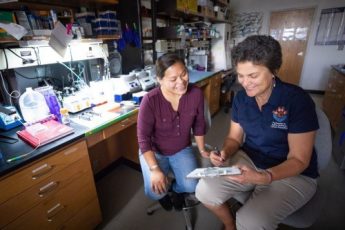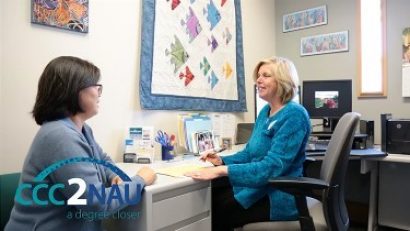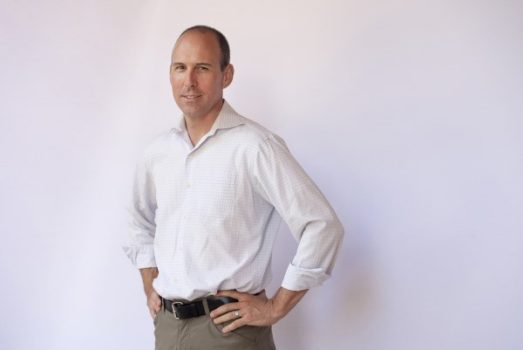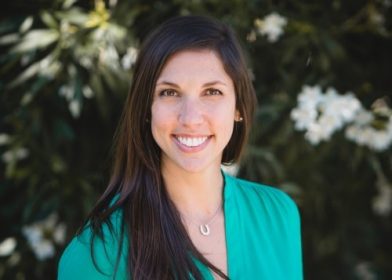Paving the Way for Transfer Students
Building Partnerships and Programs Focused on Student Success are Worth the Effort
by Leslie Mertz for the American Chemical Society
Its critical for two- and four-year colleges to work closely together to prepare students for the transition from a community college to a 4-year college or university. Yes, that takes work, but that work is more than paid off in the benefits it provides for students, for the community colleges and universities, and for the greater community, according to administrators at institutions that are making the effort.
“I think it's worth it because these are students who may need a little extra support, but have so much to offer: they are often working and supporting themselves, plus taking classes, so they’re an industrious group. If they don’t make the transition from community college to university because we haven’t removed some of those barriers, we may be missing out on some amazing talent,” said Jani Ingram, Ph.D., professor of analytical and environmental chemistry and newly named Regents’ Professor at Northern Arizona University (NAU). A former transfer student herself, she heartily supports the Coconino Community College to Northern Arizona University, or CCC2NAU, program that helps transfer students prepare for and succeed at NAU.
Community college students definitely become valuable members of the university population, agreed Jared Shaw, Ph.D., chemistry chair and professor at the University of California, Davis (UC Davis), which works hand in hand with community colleges so students move more easily from one institution to the other. “Transfer students really enhance the diversity of the classes with their different life experiences and different backgrounds, and from my perspective as a teacher, you will have a richer learning environment with these very high-achieving students. I have had nothing but positive interactions with transfer students, both in my classes and as undergraduate researchers in my lab.”
Thinking forward in Flagstaff, Arizona
In 2008, the presidents of CCC and NAU decided they wanted a seamless pipeline between the two institutions, and created an innovative joint-admissions program called CCC2NAU that “gives the students a kind of dual citizenship, so they are a student of both schools from the get-go,” described Robin Long, who manages the program for NAU. “Fast forward 13 years, and CCC2NAU is now an award-winning program with the National Academic Advising Association, and it has been replicated 20 times with all the community colleges in Arizona.”
This is how it works: When students sign up for CCC2NAU, they apply to CCC, which is where they initially take their classes, and to NAU where they are admitted as non-degree-seeking students. One of the biggest benefits of the program is on the advising side, because cross-trained NAU and CCC advisors meet regularly with students to provide a specific roadmap of the CCC courses that fit into a future NAU bachelor’s degree program, Long said. “There’s no guesswork, because the two institutions work closely together, and we know for sure that the CCC courses are equivalent to NAU courses, and they will transfer.”
The program also throws out the welcome mat with full NAU privileges to CCC2NAU students, Ingram noted. That includes the option to live on campus and buy a meal plan, purchase an activity pass to attend football or basketball games, use the NAU library and rec center, join and participate in NAU clubs, and even take a class or two at the university, “This gives them that connection to the four-year institution while they are taking classes at CCC, while also helping them think forward and see a clear path to getting their bachelor’s degree.”
Long describes CCC2NAU as a win-win-win. She remarked, “It’s obviously a win for the students on multiple levels: the smaller class sizes and lower tuition at CCC and that feeling that they are already a part of NAU. The community college wins because a third of their enrollment is CCC2NAU students. And NAU wins because the highest number of their transfer students are coming from CCC2NAU.”
In addition to CCC2NAU, Ingram directs a separate program called Bridging Arizona Native American Students to Bachelor's Degree, or BRIDGES, which is funded by the National Institutes of Health and centered on those transfer students seeking degrees in the biomedical or behavioral health fields. “Most of the BRIDGES students also enroll in CCC2NAU, but the BRIDGES program has additional activities including a research experience, resume-writing and a lot of other professional development, and role-model seminars in which Native scientists share their work,” she said. “The hope is that we help the student not just transition and get their bachelor's degrees, but also open their eyes to continuing their training into graduate school.”


Smoothing the move in California
California has an infrastructure in place to help students move from community colleges to universities, and it includes both the Transfer Admission Guarantee (TAG) program and a website at assist.org. “TAG is a contract between UC campuses and all the state community colleges stating that if community college students meet certain criteria, they are guaranteed admission to a UC campus,” described Kate Creveling, student services supervisor in the UC Davis Department of Chemistry.
Assist.org is a database that shows course equivalencies between California community colleges and all the UC and California State University campuses, so for instance, a student who takes Chemistry 400 at Sacramento City College knows exactly how that transfers to UC Davis, she said. “In addition, if students have a major in mind, they can scroll through all the course requirements for a given university, see the list of classes they should take, find those they can take at their community college prior to transfer.”
Once the students transfer to the university, UC Davis and the chemistry department both provide support services to smooth the way and help them succeed. For one thing, the advising staff at UC Davis takes a careful look at incoming students’ community college records, meeting with them separately during the orientation program prior to the start of the first quarter at UC Davis. During that orientation, students meet the chemistry department chair and vice-chairs, and also hear from peer advisors who provide “some tips and tricks” for life on the UC Davis campus, Creveling recounted.
Once the quarter is under way, the Transfer and Reentry Center is available to connect students with peer and professional networks, assist with academic skills, and generally make them feel at home on the UC Davis campus. To accommodate the many transfer students who are commuters, the center has a lounge where they can relax and hang out with other transfer students between classes, Creveling said. A department-run Chemistry Peer Mentor Program (CPMP) pairs incoming underrepresented and minority undergraduates with senior chemistry students, and also offers a one-credit, graduate student-run class to acclimate new students to the university.
“Another program for transfer students is CAMP, which is the California version of the National Science Foundation’s Louis Stokes Alliances for Minority Participation,” Shaw said. “This is a summer program for those incoming, transfer students from historically underrepresented groups who may be interested in research. Research is not the only reason to come to a big university like UC Davis, but it certainly is a big driver for science majors, so this serves as a ramp-up to joining a research group.”


Worth the effort
Designing and running transfer student-oriented programs and building and maintaining community college-university partnerships take time and effort, but Shaw, Creveling, Ingram and Long asserted that they are more than worth the commitment.
“These are students who have worked extra-hard to get to UC Davis,” Creveling said. “I’m not saying that students who start as freshman aren’t working hard as well, but there’s just this extra level of grit: “I’m going to master my coursework at the community college, because my goal is a UC campus and I am going to get there. Some are first-generation students, some are parents, some are working their way through or have obligations that are not typical of a 20-year old’s obligations, so I just find that they bring a lot of diversity and a wealth of knowledge to our classes, to our department, and the whole university community.”
Supporting transfer students also benefits the broader community by cultivating a better trained workforce, Long said, so strong community college-university partnerships have far-reaching, positive implications.
Added Ingram, “Sometimes I’ll hear people pooh-pooh transfer students, and I’ll stop them and say, ‘Wait a minute. That was me. I was that transfer student.’ So, I do have a personal passion for programs like CCC2NAU and BRIDGES, and I’ve seen so many transfer students go through NAU and do great things and that's why institutions should not overlook community college students. Instead, universities should really work on those partnerships and the programs to support them.”
“These are students who have worked extra-hard to get to UC Davis..I’m not saying that students who start as freshman aren’t working hard as well, but there’s just this extra level of grit: “I’m going to master my coursework at the community college, because my goal is a UC campus and I am going to get there. Some are first-generation students, some are parents, some are working their way through or have obligations that are not typical of a 20-year old’s obligations, so I just find that they bring a lot of diversity and a wealth of knowledge to our classes, to our department, and the whole university community.” - Kate Creveling, UC Davis

